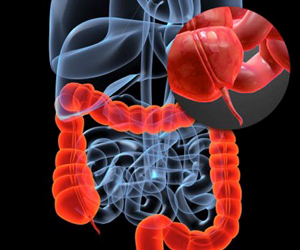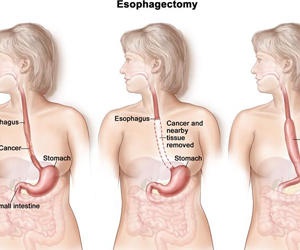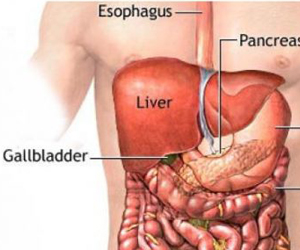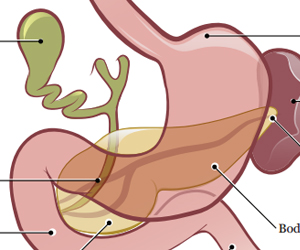GI Oncology
 These are surgeries aimed at treating cancers and other tumors arising from the GI tract. Key principles of these surgeries include
These are surgeries aimed at treating cancers and other tumors arising from the GI tract. Key principles of these surgeries include
- Radical surgery ensuring complete removal of even microscopic tumor. Here “no touch technique” is followed in that the tumor handling is reduced to minimum possible for avoiding spread of tumor cells into the blood stream.
- Functional preservation of adequate functional residual liver/intestine for speedy recovery
Advances in laparoscopy and robotic surgery help in doing these procedures with less postoperative pain.
 Esophagus or food pipe is the organ which begins in the neck, passes through the chest and ends in abdomen. Exposure to esophagus for treating tumors till now used to involve opening multiple body cavities (chest and abdomen). Also the proximity of esophagus to important blood vessels of the heart resulted in limited exposure. The recent advances in these surgeries include
Esophagus or food pipe is the organ which begins in the neck, passes through the chest and ends in abdomen. Exposure to esophagus for treating tumors till now used to involve opening multiple body cavities (chest and abdomen). Also the proximity of esophagus to important blood vessels of the heart resulted in limited exposure. The recent advances in these surgeries include
- Minimal access techniques (thoracoscopy and laparoscopy) and robotic surgery: surgeries are more safe and less painful. Accurate identification of important surrounding structures is key to safe surgery since esophagus passes through the neck, thorax and esophagus.
- Good perioperative care: Bronchoscopic clearance of chest secretions and cardiac care helps patients recover early by preventing chest infections which used to be common with open surgeries.
- Adequate lymph node clearance: This reduces the chances of recurrence of tumors. Advances in chemotherapy and radiation also are improving patient survival.
Some rare tumors like leiomyomas and GIST can also be treated with minimal access surgery and these patients have very good outcomes following treatment.
 Removal of a portion of stomach is usually needed for cancers involving the stomach. Depending on the extent of stomach removed (dependent on the size and location of the tumor ), these are variously called as partial , subtotal or total (complete) gastrectomy. Extended lymphadenectomy and multiorgan resections help in treating patients with advanced tumors. Gastric cancers being highly aggressive need wide resection of stomach and also the lymphatic basin for a curative resection.
Removal of a portion of stomach is usually needed for cancers involving the stomach. Depending on the extent of stomach removed (dependent on the size and location of the tumor ), these are variously called as partial , subtotal or total (complete) gastrectomy. Extended lymphadenectomy and multiorgan resections help in treating patients with advanced tumors. Gastric cancers being highly aggressive need wide resection of stomach and also the lymphatic basin for a curative resection.
Small and less aggressive tumors like GIST (GI stromal tumors) can be treated with a sleeve (wedge) gastrectomy preserving major portion of stomach. All the above surgeries can be done laparoscopically depending on the extent of the tumor.
 Resection of a segment of large intestine is usually indicated to either remove a tumor or any obstructing/ bleeding disease (Crohn’s/ tubercular) involving that segment of the intestine. Depending on the location and extent of the intestine removed, these are variously called as
Resection of a segment of large intestine is usually indicated to either remove a tumor or any obstructing/ bleeding disease (Crohn’s/ tubercular) involving that segment of the intestine. Depending on the location and extent of the intestine removed, these are variously called as
- Right or left hemicolectomy: half of the colon, either on the right side (caecum and ascending colon) or left side (descending colon): usually for localized tumors of the colon
- Segmental colectomy: short segment of colon is removed for either a benign condition (sigmoid colectomy for diverticulitis) or a very small tumor
- Subtotal or total colectomy: This involves complete or near complete resection of the whole large intestines. This is usually reserved for patients with diseases involving whole of the colon (ulcerative colitis) or multiple simultaneous tumors.
Surgery involves removal of not only the involved segment of the intestine, but also its lymphatic drainage along the feeding blood vessels for proper microscopic clearance of tumor. Due to advances in staplers and imaging modalities, all the above can be done laparoscopically to ensure faster recovery.
 Removal of a portion of pancreas is usually needed to remove a tumor of the pancreas. Depending on the location and extent of the removed pancreas, these are of the following types:
Removal of a portion of pancreas is usually needed to remove a tumor of the pancreas. Depending on the location and extent of the removed pancreas, these are of the following types:
Distal pancreatectomy: This involves removal of body and/or tail of pancreas. This is a relatively simpler surgery since there is no need for any reconstruction after removal of this segment of pancreas. This can be performed laparoscopically.
Whipple’s pancreaticoduodenectomy: Removal of head of pancreas is more complicated in view of its close relation to various blood vessels and liver. This procedure needs careful separation of head of the pancreas from major blood vessels. This also needs reconstruction of the cut segments of bile duct pancreas, stomach and small intestine by an experienced surgeon for safe and adequate surgery.
Central pancreatectomy: This involves the removal of a small portion from the middle of the pancreas. This is usually performed for very small tumors.
